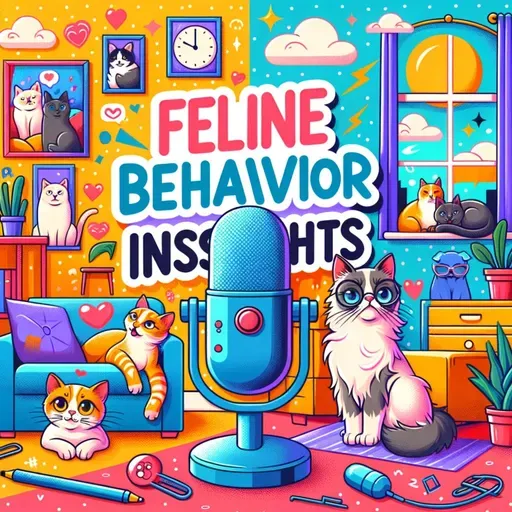
12 September 2025
The Language of Cats: Decoding Feline Body Language and Behavior
Feline Behavior Insights
About
Curious listeners, ever wondered what goes on inside the mysterious mind of a cat? Feline behavior is a fascinating blend of instinct, communication, and mood, and understanding it can be key to building a deeper bond with your whiskered companion. According to experts at PetMD, cats use a sophisticated palette of body language and vocalizations to tell us how they’re feeling and what they need. For example, a happy cat will show a relaxed posture, sometimes stretching its limbs and tail, or even exposing its belly—a gesture that signals trust, though it’s not always an invitation for a belly rub. That classic slow blink is a feline way of saying, “I trust you.” Try blinking back slowly to return the affection.
A confident cat may walk with an upright tail, sometimes curled at the tip. If you see your cat kneading with its paws, MedVet notes this is a sign of deep contentment rooted in kittenhood, when kneading helped stimulate milk flow. Head bunting and rubbing isn’t just adorable—it’s a heartfelt display of affection and territorial marking, thanks to scent glands on a cat’s face.
Of course, play is central to a cat’s daily routine. Even a simple “wiggle and pounce” is more than fun—it’s a rehearsal of hunting skills. During play, they may crouch, swish their tail, and dilate their pupils. Express Vets Buford says a tail held in an upside-down U is a sign of feline excitement, while flicking or twitching indicates anticipation or even annoyance.
On the flip side, recognizing stress or discomfort in your cat is vital. PetMD reports that a tense body held low to the ground, ears pulled back, and a tail thumping or held close to the body are signs a cat is on edge. Displacement behaviors like excessive licking or grooming might mean your cat is trying to cope with anxiety. In more serious cases, a stressed kitty might urinate outside the litter box, signaling it’s time for a wellness check or environmental adjustment.
Aggressive signals are universal—arched back, puffed-up fur, and wide eyes all mean the cat feels threatened. According to Wikipedia, this is usually defensive rather than an act of malice. Flattened ears, growling, or hissing are warnings to provide space and remove any perceived threat. Close observation of your cat’s non-verbal cues—like tail position, ear movement, and overall posture—can help you intervene before play turns stressful or an encounter escalates.
Even knocking things off countertops or bringing “gifts” to their humans comes straight from their natural instincts—exploration, hunting, and group bonding. By learning to interpret these small but meaningful actions, listeners can strengthen the human-cat relationship and provide a more enriching environment for their feline companion.
Thanks for tuning in and don’t forget to subscribe. This has been a quiet please production, for more check out quiet please dot ai.
For more http://www.quietplease.ai
Get the best deals https://amzn.to/3ODvOta
A confident cat may walk with an upright tail, sometimes curled at the tip. If you see your cat kneading with its paws, MedVet notes this is a sign of deep contentment rooted in kittenhood, when kneading helped stimulate milk flow. Head bunting and rubbing isn’t just adorable—it’s a heartfelt display of affection and territorial marking, thanks to scent glands on a cat’s face.
Of course, play is central to a cat’s daily routine. Even a simple “wiggle and pounce” is more than fun—it’s a rehearsal of hunting skills. During play, they may crouch, swish their tail, and dilate their pupils. Express Vets Buford says a tail held in an upside-down U is a sign of feline excitement, while flicking or twitching indicates anticipation or even annoyance.
On the flip side, recognizing stress or discomfort in your cat is vital. PetMD reports that a tense body held low to the ground, ears pulled back, and a tail thumping or held close to the body are signs a cat is on edge. Displacement behaviors like excessive licking or grooming might mean your cat is trying to cope with anxiety. In more serious cases, a stressed kitty might urinate outside the litter box, signaling it’s time for a wellness check or environmental adjustment.
Aggressive signals are universal—arched back, puffed-up fur, and wide eyes all mean the cat feels threatened. According to Wikipedia, this is usually defensive rather than an act of malice. Flattened ears, growling, or hissing are warnings to provide space and remove any perceived threat. Close observation of your cat’s non-verbal cues—like tail position, ear movement, and overall posture—can help you intervene before play turns stressful or an encounter escalates.
Even knocking things off countertops or bringing “gifts” to their humans comes straight from their natural instincts—exploration, hunting, and group bonding. By learning to interpret these small but meaningful actions, listeners can strengthen the human-cat relationship and provide a more enriching environment for their feline companion.
Thanks for tuning in and don’t forget to subscribe. This has been a quiet please production, for more check out quiet please dot ai.
For more http://www.quietplease.ai
Get the best deals https://amzn.to/3ODvOta